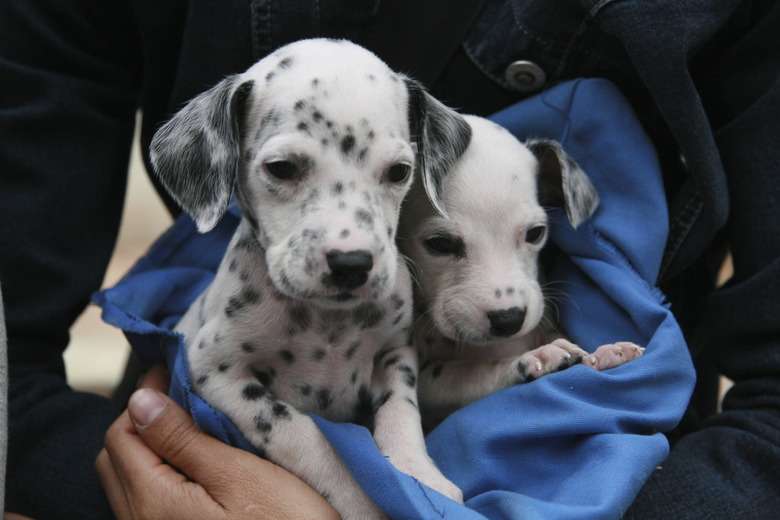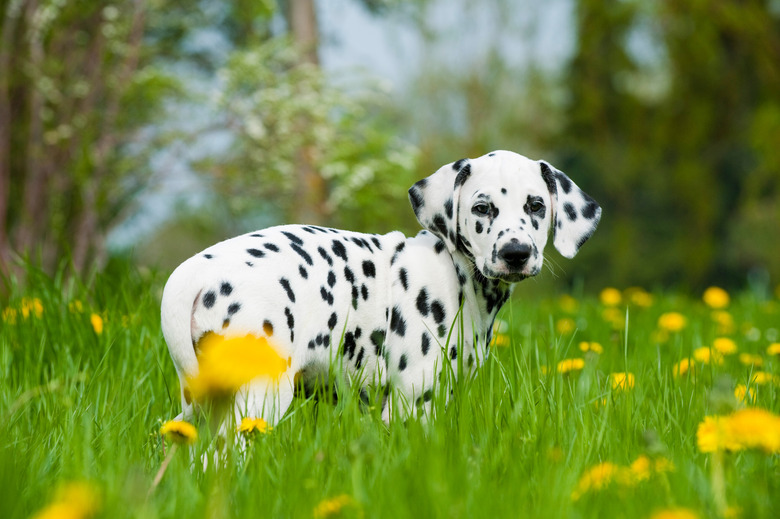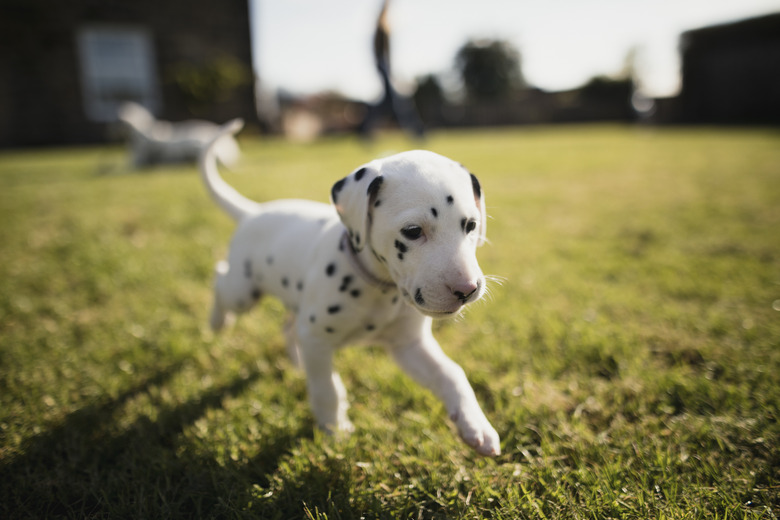When Do Dalmatian Puppies Get Their Spots?
You may remember that in the "101 Dalmatians" story, Cruella de Ville is dismayed when she swoops in to view the new puppies and sees that they have no spots. Anita correctly tells her that Dalmatian puppies are born with pure white coats without their characteristic spots. So, at what age do Dalmatian puppies get their spots? It varies, but most puppies begin to get their spots when they're between 10 days and two weeks old, and spots can continue to appear and darken for 18 months.
Tip
Dalmatian puppies are born with white coats, but their spots begin to appear when they are between 10 days and two weeks old.
Waiting for the spots
Waiting for the spots
If you look closely, you may see the spots faintly on the skin of Dalmatian puppies, even from birth. You just can't see the spots through their pure white fur. It will take 10 days to two weeks before you can tell whether their spots will be black, as Dalmatians are typically thought of and pictured, or the chocolate-brown color that is officially called liver or liver brown, the two colors accepted as standard by the American Kennel Club (AKC).
Dalmatians can surprise you with other color combinations, however, including white and lemon; white and orange; white, black, and tan; and white, liver, and tan. While these colorings are also beautiful, they are cause for disqualification in dog shows. The spots themselves also have qualifying and disqualifying characteristics. They should be distinctly round, rather than patchy, and between the size of a dime and a half-dollar. Spots on the head, ears, and tail are typically smaller than those on the body.
Other Dalmatian characteristics
Other Dalmatian characteristics
Dalmatians are short-haired, medium-sized dogs, standing from 19 to 25 inches tall at the withers (top of the shoulder blade) and weighing between 45 and 70 pounds. While the fur is short, it sheds profusely and should be thoroughly brushed weekly. The Dalmatian's skin lacks the oils that give other dogs their odor, so they only need to be bathed when they appear dirty from being outdoors.
Beneath their sleek coats is a muscular, strong body that has been described as elegant or dignified. They have a smooth gait and energy that seemingly never stops, making Dalmatians good companions for athletic owners who like the outdoors and want a dog that can keep up with them as they run, bike, or take long hikes. After about two years of age, Dalmatians will have grown enough to keep up; before that age, keep distances shorter and work up to longer ones.
Aloof, loving, and loyal
Aloof, loving, and loyal
Dalmatians can appear to be aloof due to their elegant stance and tendency to view strangers warily until they warm up to them. To their owners, though, they are loving and loyal. When introducing a Dalmatian to young kids, teach children to interact with the dog gently and kindly, without pulling tails, yanking on fur, or trying to hug the dog. Make sure the Dalmatian's need for exercise is met by going on a long walk each day, perhaps with the young child in a stroller.Dalmatians do well with older children who can understand how and where the dog prefers to be petted; older kids can also play fetch with them and take them for walks.
If you're bringing a new baby into a home where your Dalmatian is already established and comfortable, go slowly with introductions. Have someone else hold your dog on his leash and allow him to sniff the baby. With each meeting, allow them to spend a little more time together while you still watch and hold the baby, and praise the dog for positive interactions like inquisitive sniffing rather than growling or barking. You can even prepare the dog before the baby comes by taking the empty stroller with you on walks, and setting out the powders, lotions, and diaper bag you'll be using so the sights and smells are familiar.
History of the breed
History of the breed
Where Dalmatians originally got their start is debatable, but they can definitively be placed in a part of central Europe that was known as Dalmatia 400 years ago. They seemed to roam with the nomadic Romani clans, perhaps demonstrating their ability to keep up with the horses and carriages that moved Romani from town to town. Years later, they were known as coach dogs because they ran alongside British noblemen's carriages to keep other dogs and people away. This is why Dalmatians make such good watchdogs today.


